Archive for 2017
‘Remembering Reading’s Heroes’ – a talk at Haslams Estate Agents for Reading FC and ABF The Soldiers’ Charity
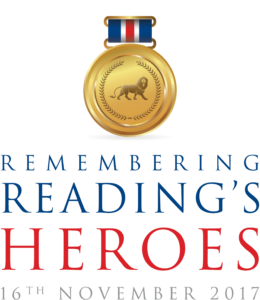
Last week I gave a talk on behalf of Haslams Estate Agents and Reading Football Club in Haslams’ flagship office in Friar Street, Reading. The talk was part of a fundraising evening for ABF The Soldiers’ Charity and was attended by over 80 people.
The evening started with drinks and canapés (based on wartime fare which included such things as spam fritters and Maconochie’s steak pies) before 25 minutes from me discussing Reading in the Great War.

Canapés were based on a wartime theme
Most of the audience had little knowledge of this period of history and I was able to explain some of the more interesting stories I had found in my research. These included the story of Max Seeberg, a former Reading FC player from the 1912–13 season who, by the time was declared in August 1914, had retired and was working as a publican. Despite being a well-known and liked member of Reading’s community his German ancestry ensured he was locked up for the duration of the war. Remarkably, he seemed to bear no malice to Britain, becoming a naturalised British subject in 1920.

Talking about Max Seeburg, a former Reading FC player who was locked up for the duration of the war due to his German nationality
I also spoke about Ronnie Poulton Palmer, the England rugby player, Trooper Fred Potts VC and the tragic case of the Sutton family (of Sutton Seeds) whose five boys went off to war. By the end of March 1918 four of them had been killed, leaving Leonard Sutton (a wartime mayor of Reading) with his sole remaining son, Noel who survived the conflict despite being torpedoed mid-channel by a German U-Boat.
After a break for more drinks and canapés an auction and raffle was held. A weekend on the battlefield with me was auctioned off by local resident, Chris Tarrant. Over £3,000 was raised for ABF The Soldiers’ Charity.
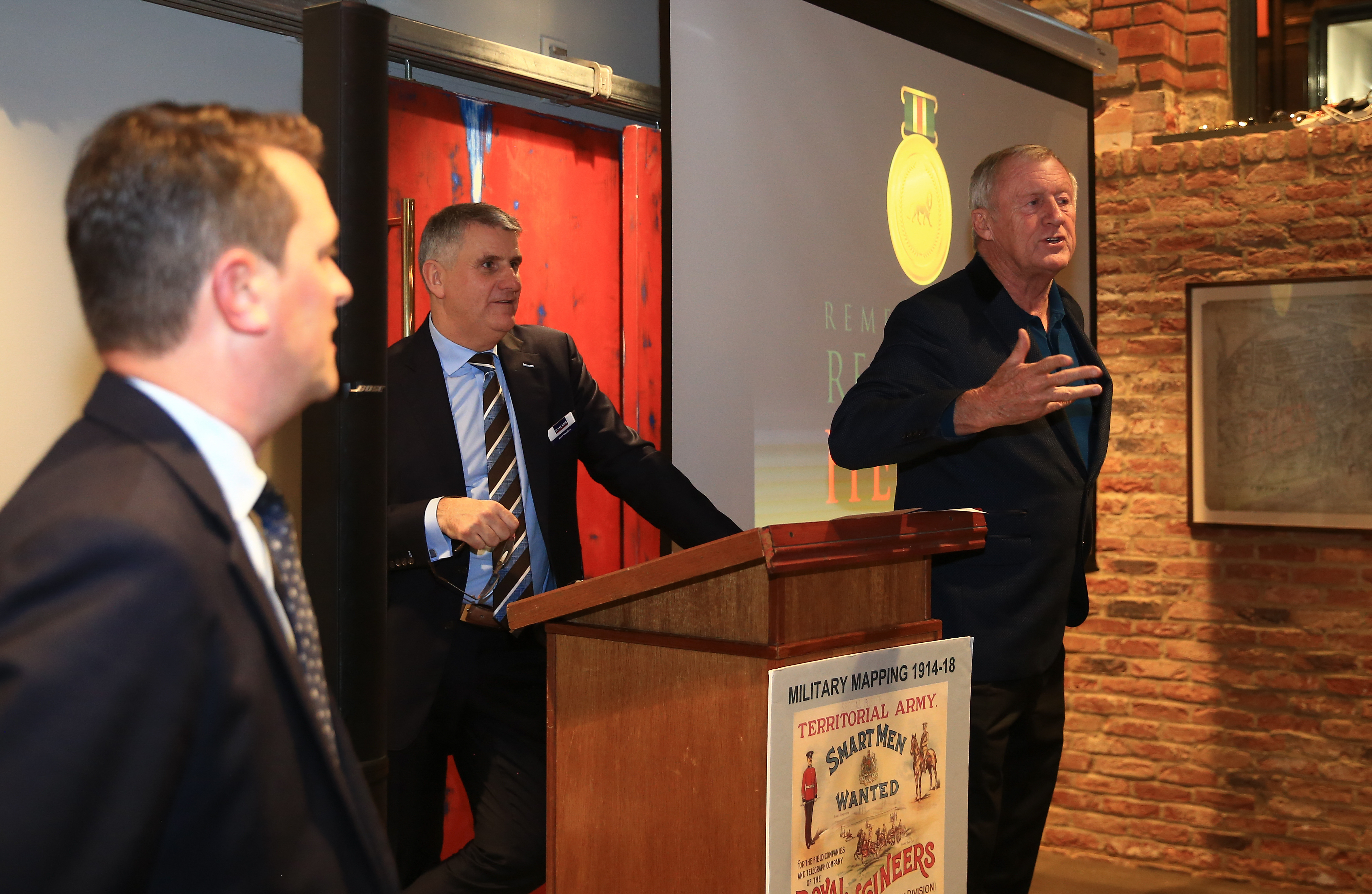
Chris Tarrant auctions a weekend on the battlefield with me to raise funds for ABF The Soldiers’ Charity
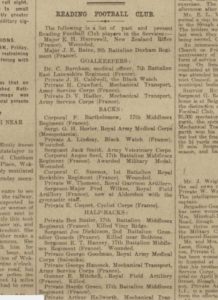
An extract from the Reading Mercury of 12 August 1916 listing players associated with Reading Football Club serving in the forces
The second half of my talk focused on telling the story of a number of Reading FC players and their wartime service. Nine former players died in the conflict whilst others such as Joe ‘Bubbles’ Bailey achieved remarkable success as a fighting officer. In Joe’s case this resulted in the award of the DSO and three Military Crosses, all in a period of just seven months in 1918!
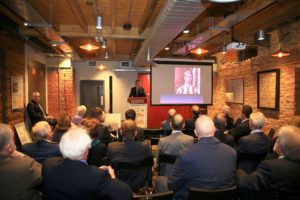
Speaking about Joe Dickenson, ‘the Footballing Grenadier’ who served in the 2nd Grenadier Guards and was killed at the Battle of Festubert in May 1915
My thanks to BBC Radio Berkshire’s Graham McKechnie, military historian Jon Cooksey and Reading FC historian Alan Sedunary who conducted a great deal of research on these players back in 2014.
The entire evening was a great success and I look forward to working with Haslams and Reading FC again in the future.
A selection of images from the evening (courtesy of Ben Hoskins http://www.bhoskins.com/) are shown below.
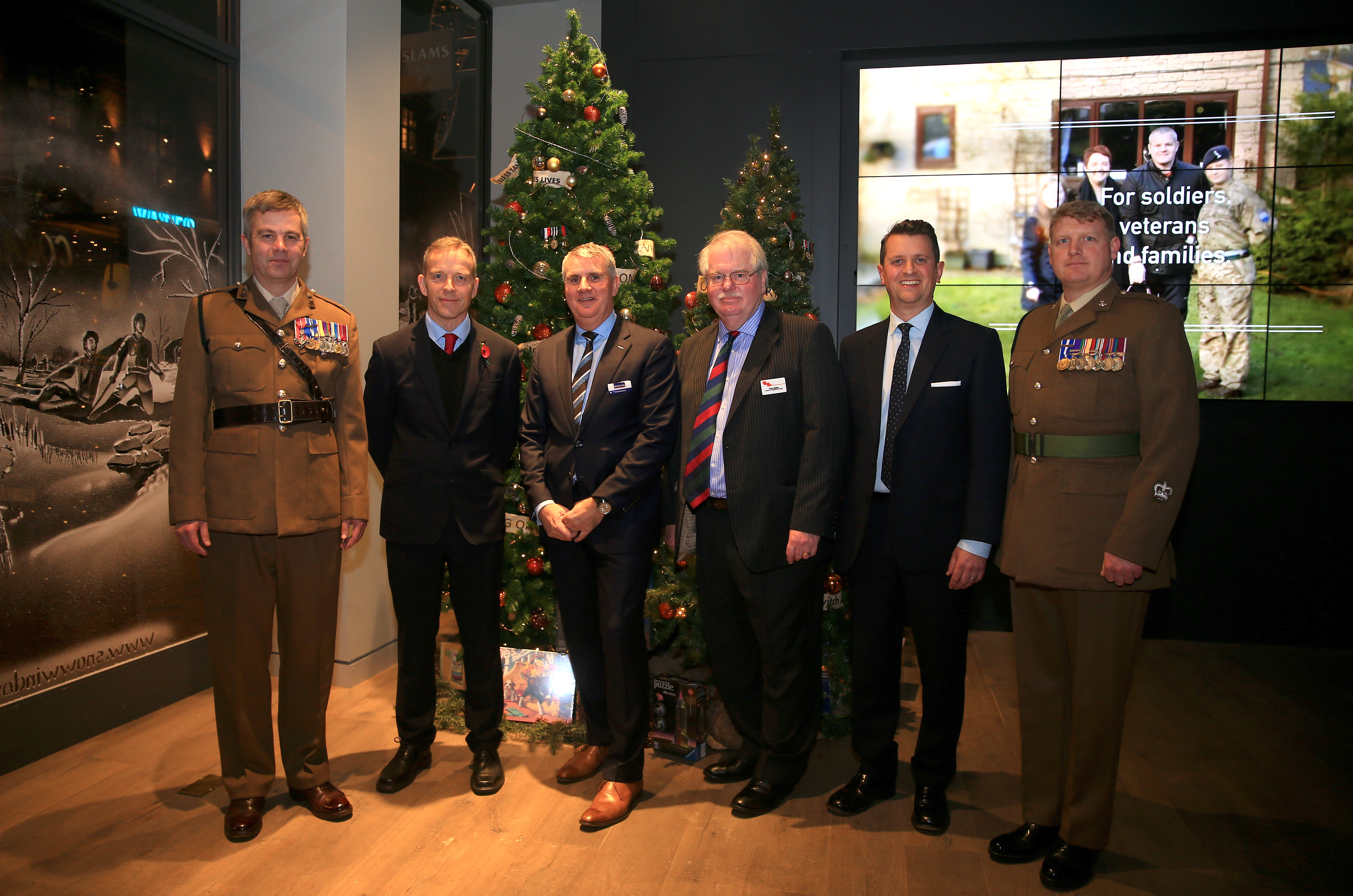
With Steve Woodford of Haslams, Brigadier Peter Walker of ABF The Soldiers Charity and serving soldiers
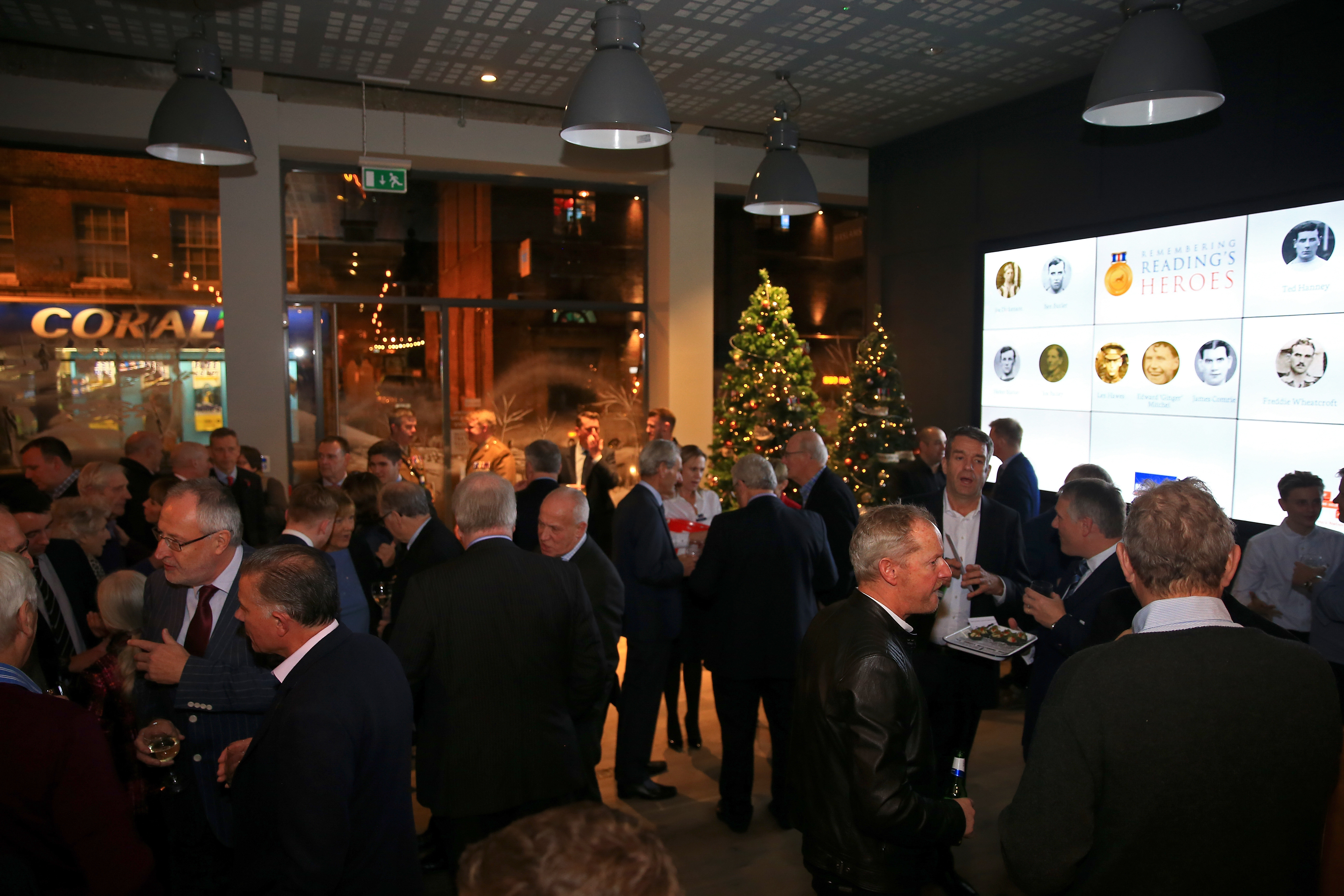
Pre-talk drinks and canapés
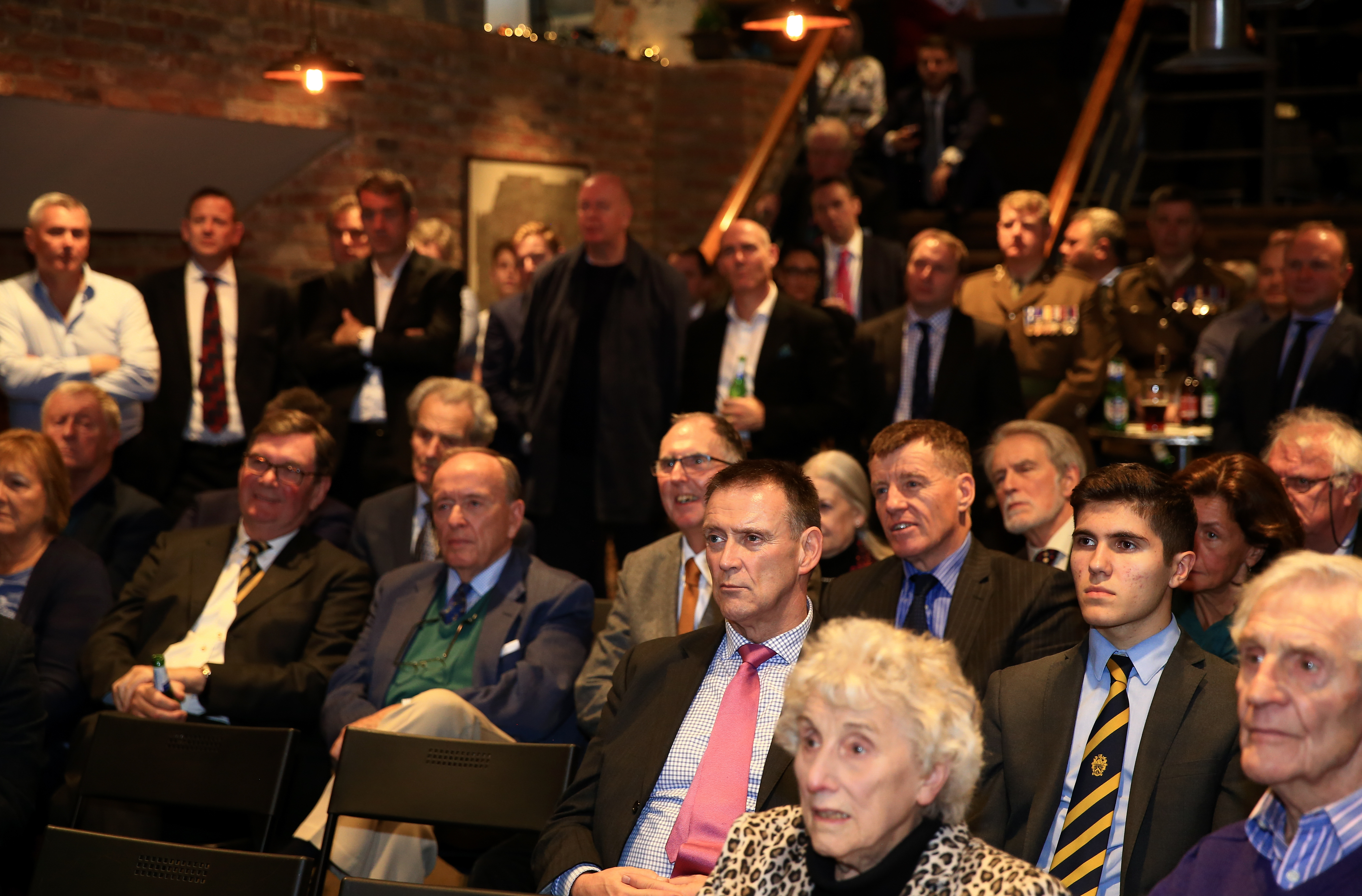
The audience seemed to enjoy the talk
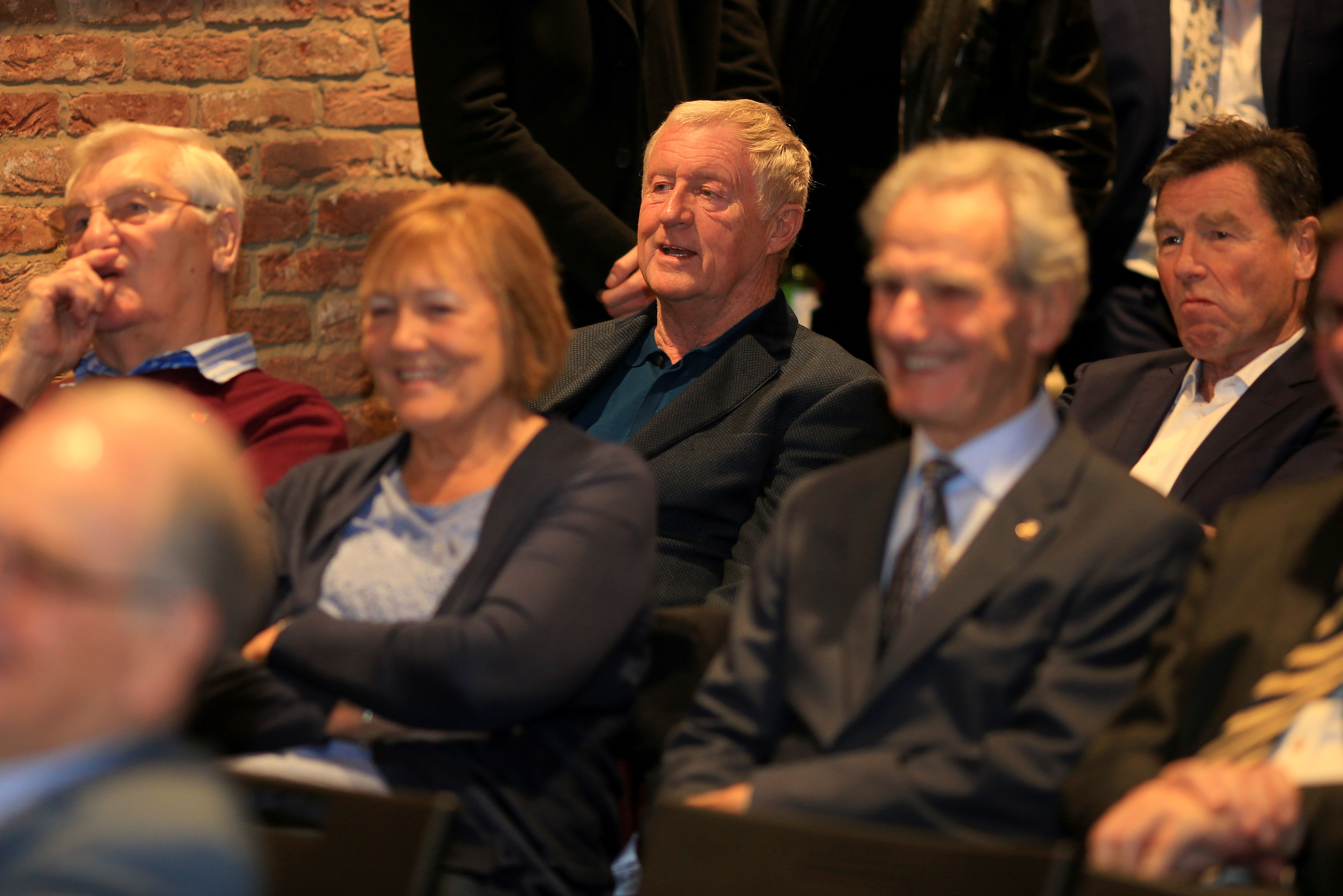
More audience shots
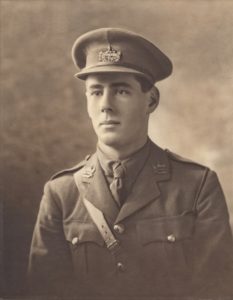
Second Lieutenant Hardy Falconer Parsons VC, 14th Gloucestershire Regiment. Image courtesy Soldiers of Gloucestershire Museum, Ref GLRRM:04750.6
Today saw the unveiling of a Bristol Civic Society blue plaque at the former Bristol home of my local Victoria Cross recipient, 2/Lt Hardy Falconer Parsons VC, 14th Gloucestershire Regiment. He lived a fifteen minute walk from my house and I have known his story for the past fourteen years that I have lived in the city.
My colleague Clive Burlton and I were determined to see Hardy’s strong association with Bristol and the West Country recognised. As his Government funded VC commemorative stone was unveiled in Rishton, Lancashire back in August we have spent the last year working on honouring Hardy’s local connections with a Bristol Civic Society blue plaque.
The plaque was unveiled by the Archie Smith and Grace Tyrrell, Head Boy and Head Girl of Kingswood School along with the Lord Mayor of Bristol, Cllr Lesley Alexander. The ceremony was attended by members of the Bristol Civic Society; the former Gloucestershire Regiment; the Soldiers of Gloucestershire Museum; the Bristol University Officer Training Corps; Kingswood School, Bath, Redland Green School and Dolphin Schools in Bristol; bandsmen from the Salamanca Band of the Rifles Regiment; members of the Western Front Association and the Bristol Great War network and representatives of the Kingswood Association, whose generous donation enabled the plaque to be made and installed. Also attending were the Deputy Lord-Lieutenant for the County and City of Bristol, Colonel Andrew Flint and the Dean of Bristol, the Very Rev Dr David Hoyle. In total, around 100 people were in attendance for the ceremony. Afterwards a sizeable number of us were invited back to the Artillery Grounds on Whiteladies Road for light refreshments as guests of Bristol University Officer Training Corps.
Images of the unveiling ceremony can found below, followed by the culmination of much detailed research into Hardy’s life by Clive Burlton and myself. I can only hope that the people of Bristol and Bath embrace his memory. He deserves that.
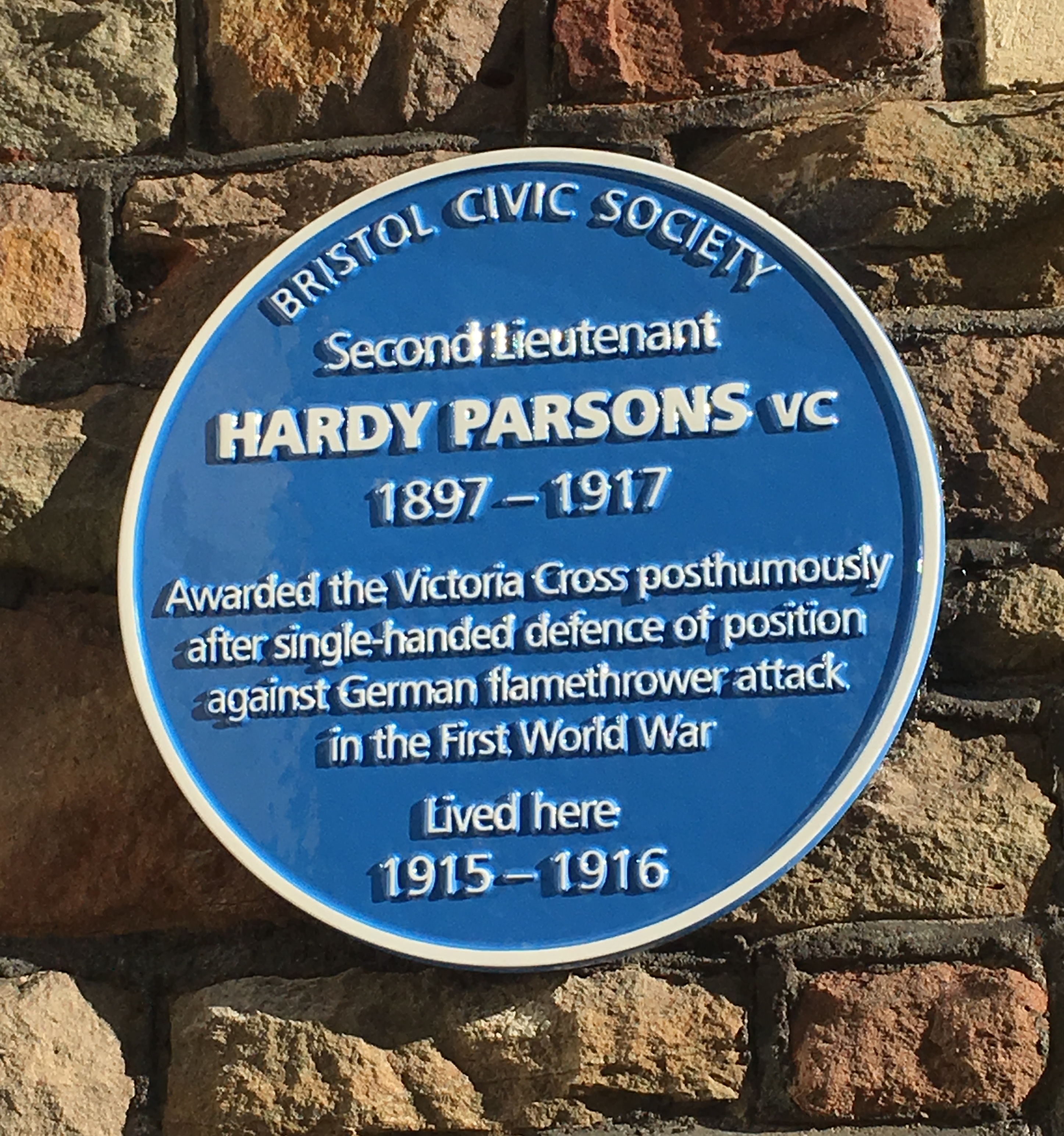
Blue plaque for Hardy Falconer Parsons VC at 54, Salisbury Road, Redland, Bristol
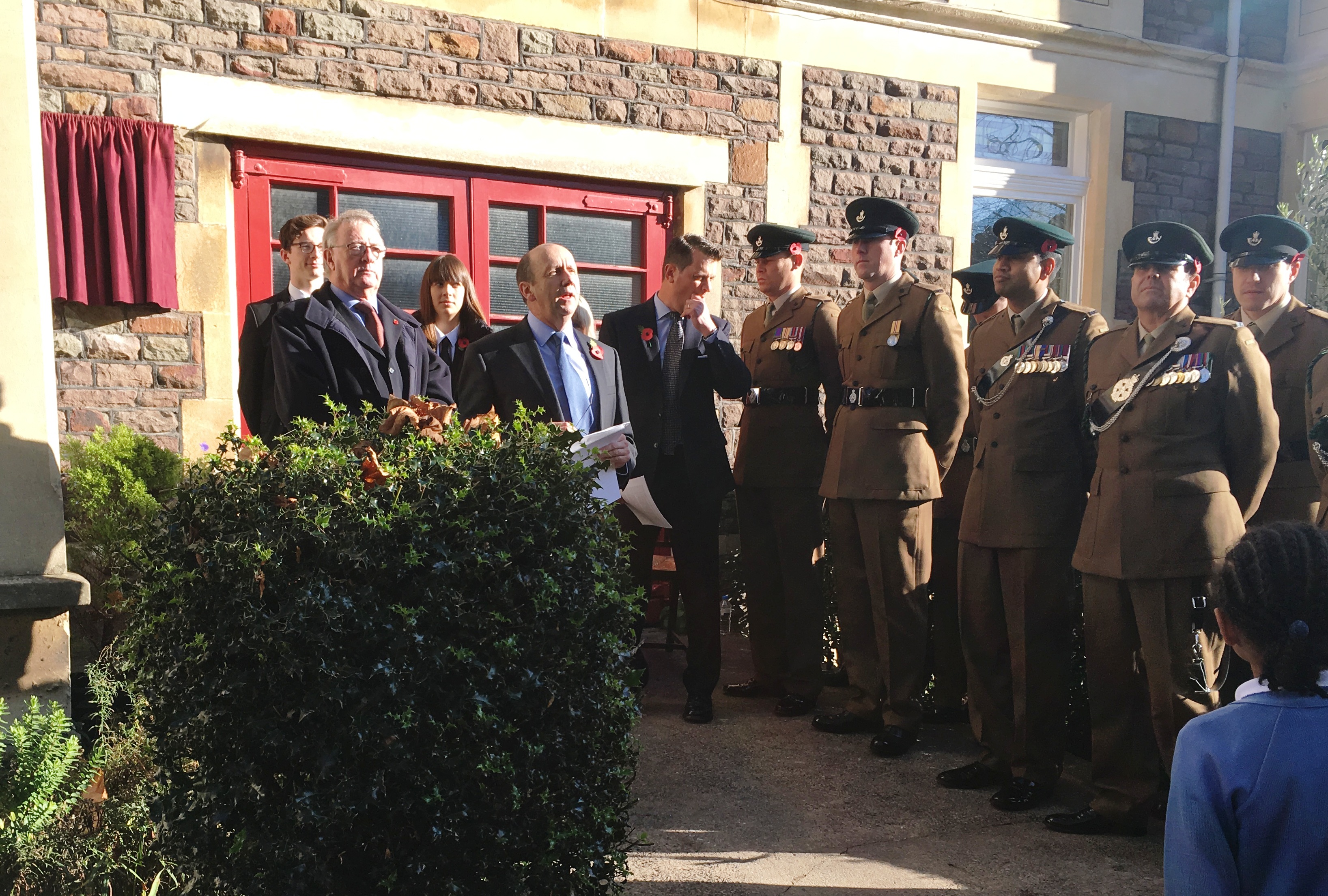
Clive Burlton gives the opening address
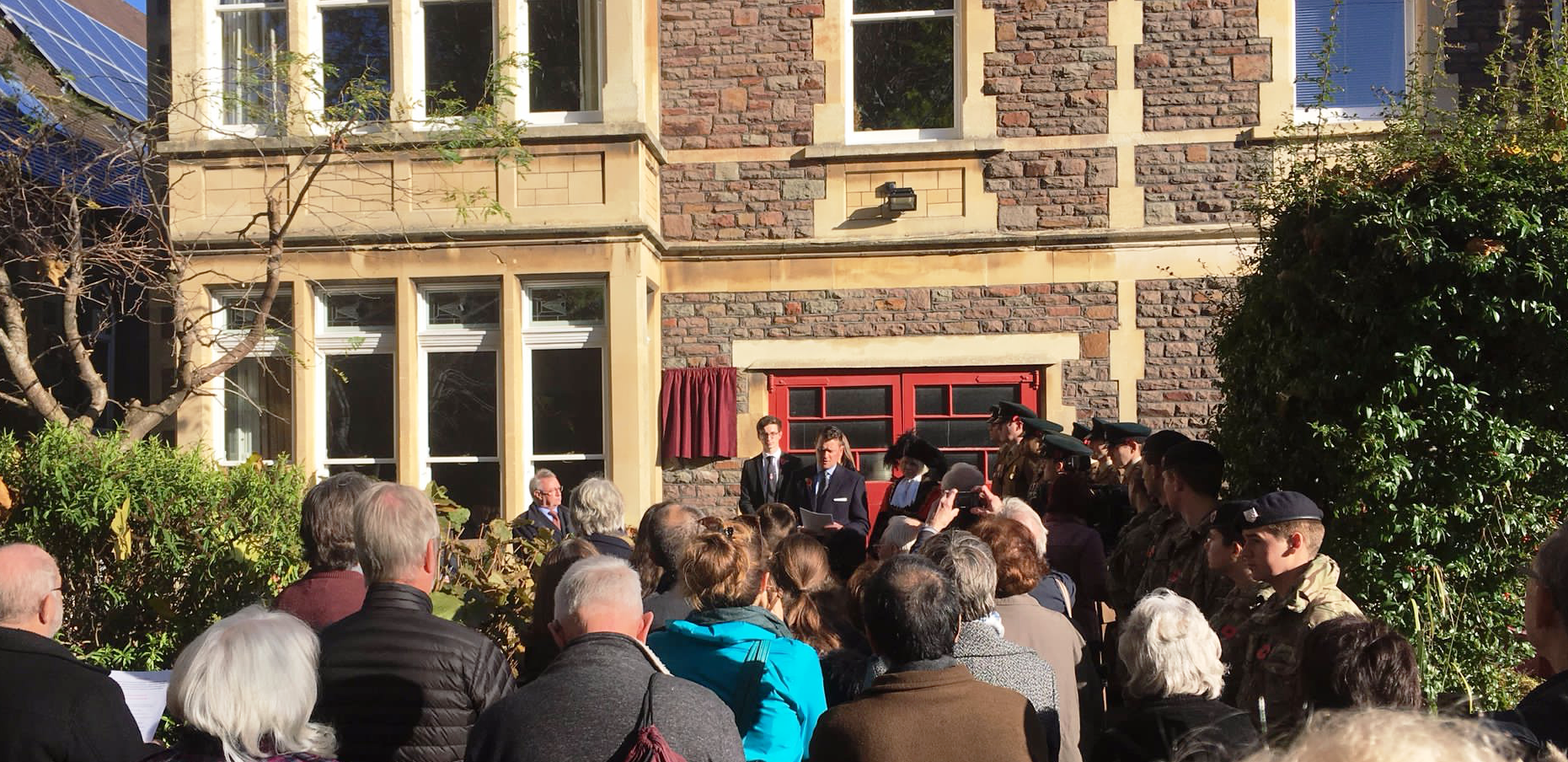
Jeremy Banning providing the historical background to the life of Hardy Falconer Parsons VC
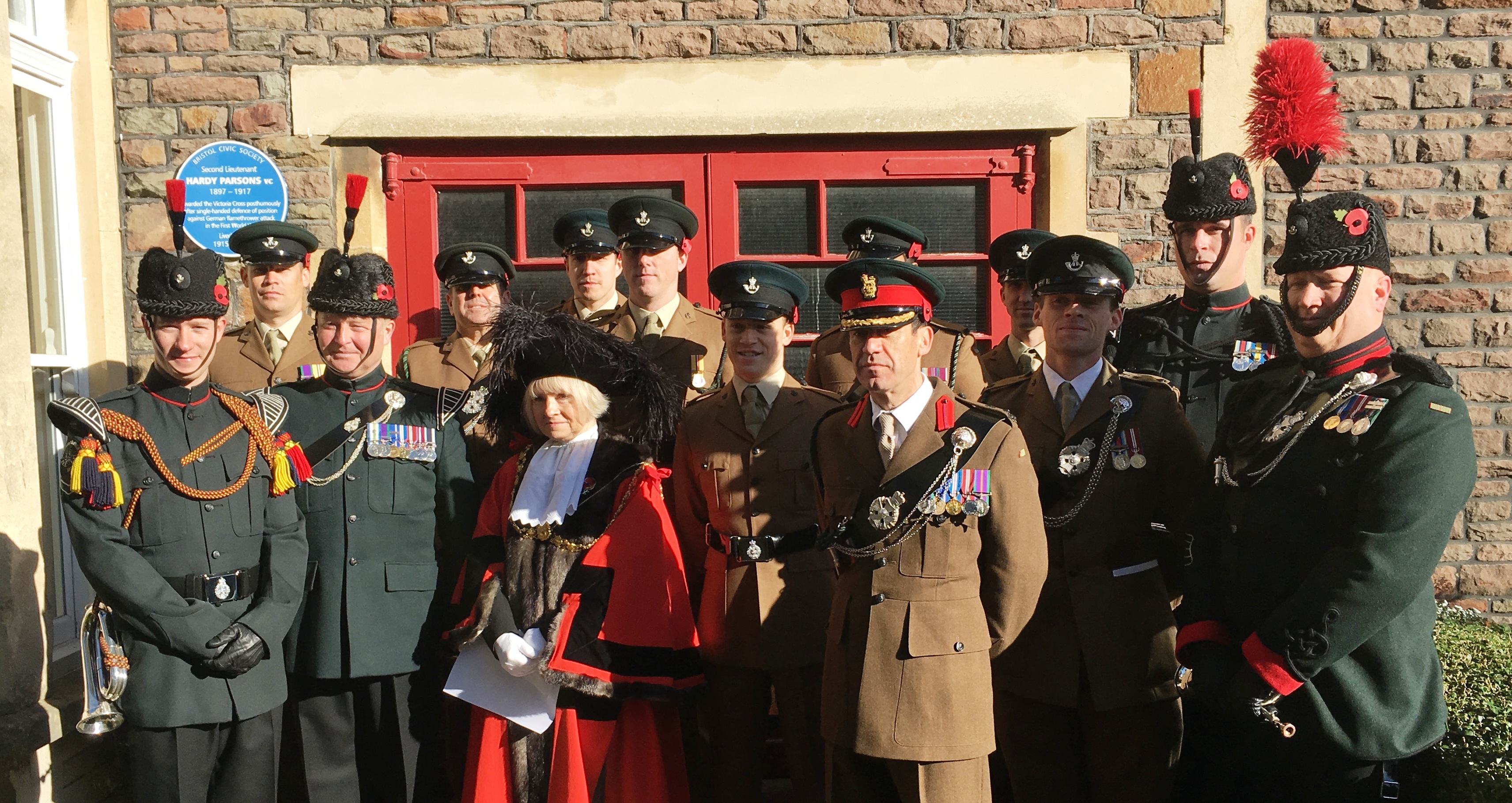
The Lord Mayor of Bristol with members of Bristol University Officer Training Corps and bandsmen from the Salamanca Band of the Rifles
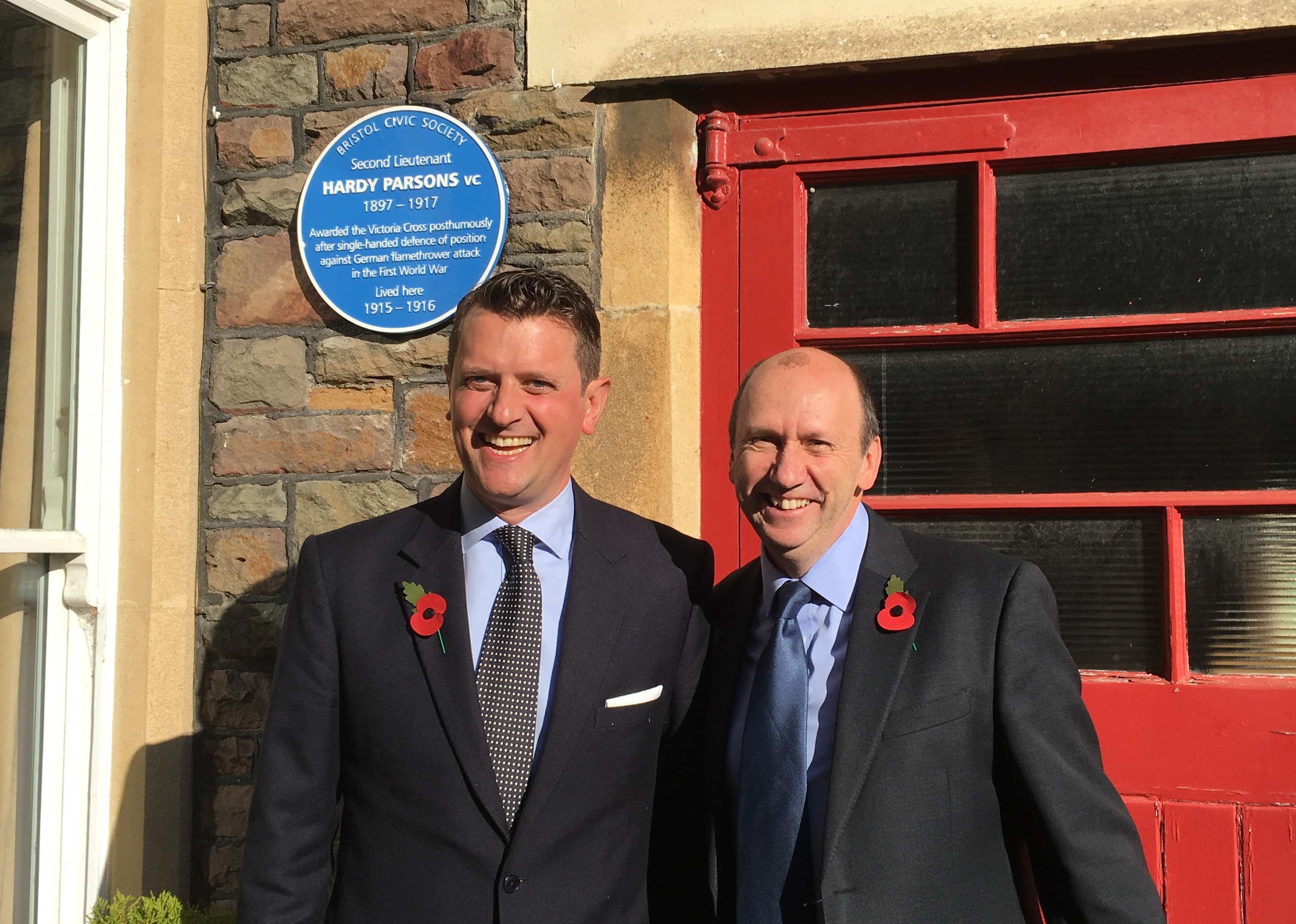
A delighted Jeremy Banning and Clive Burlton with Hardy’s new blue plaque
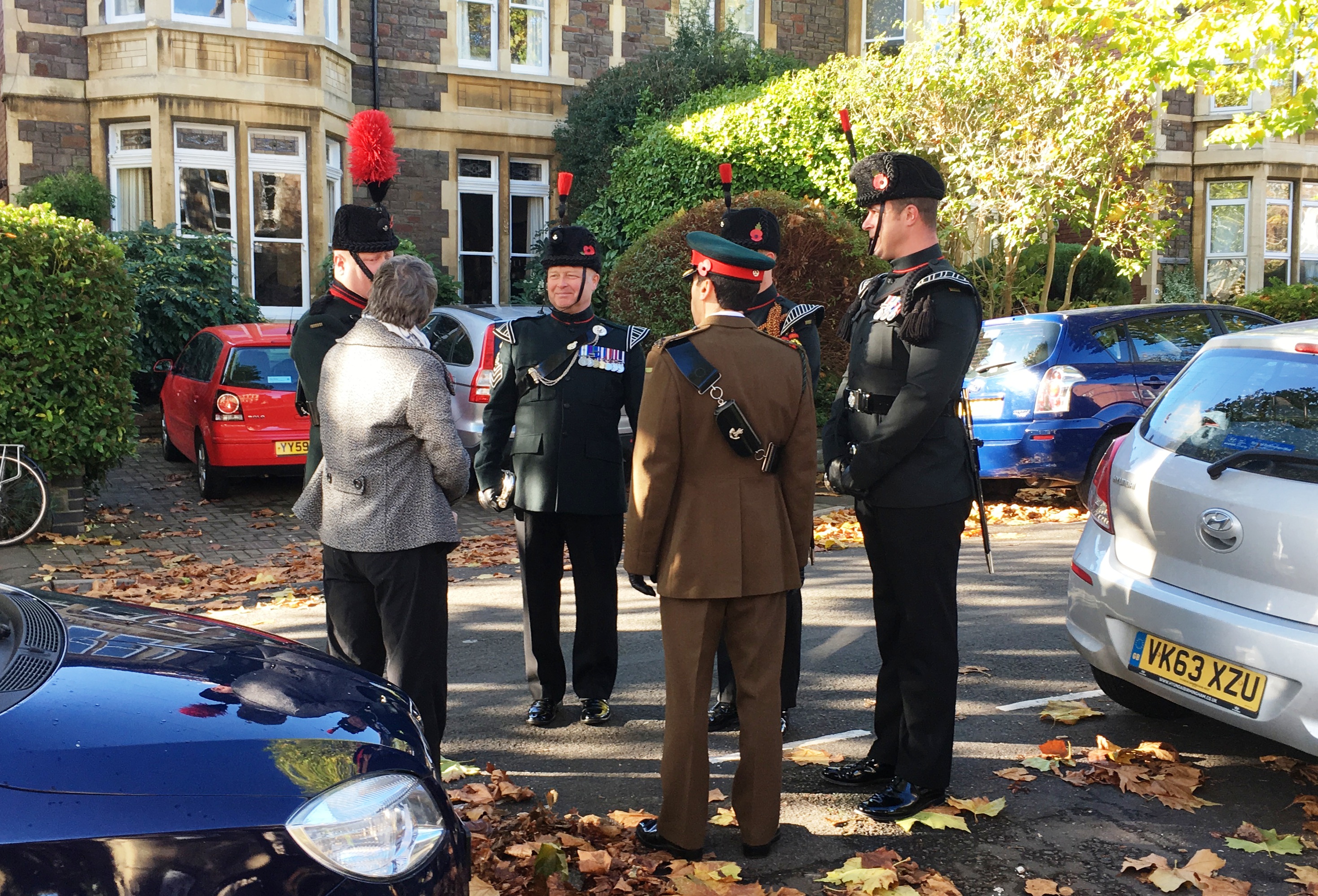
The ceremony was well attended by the military
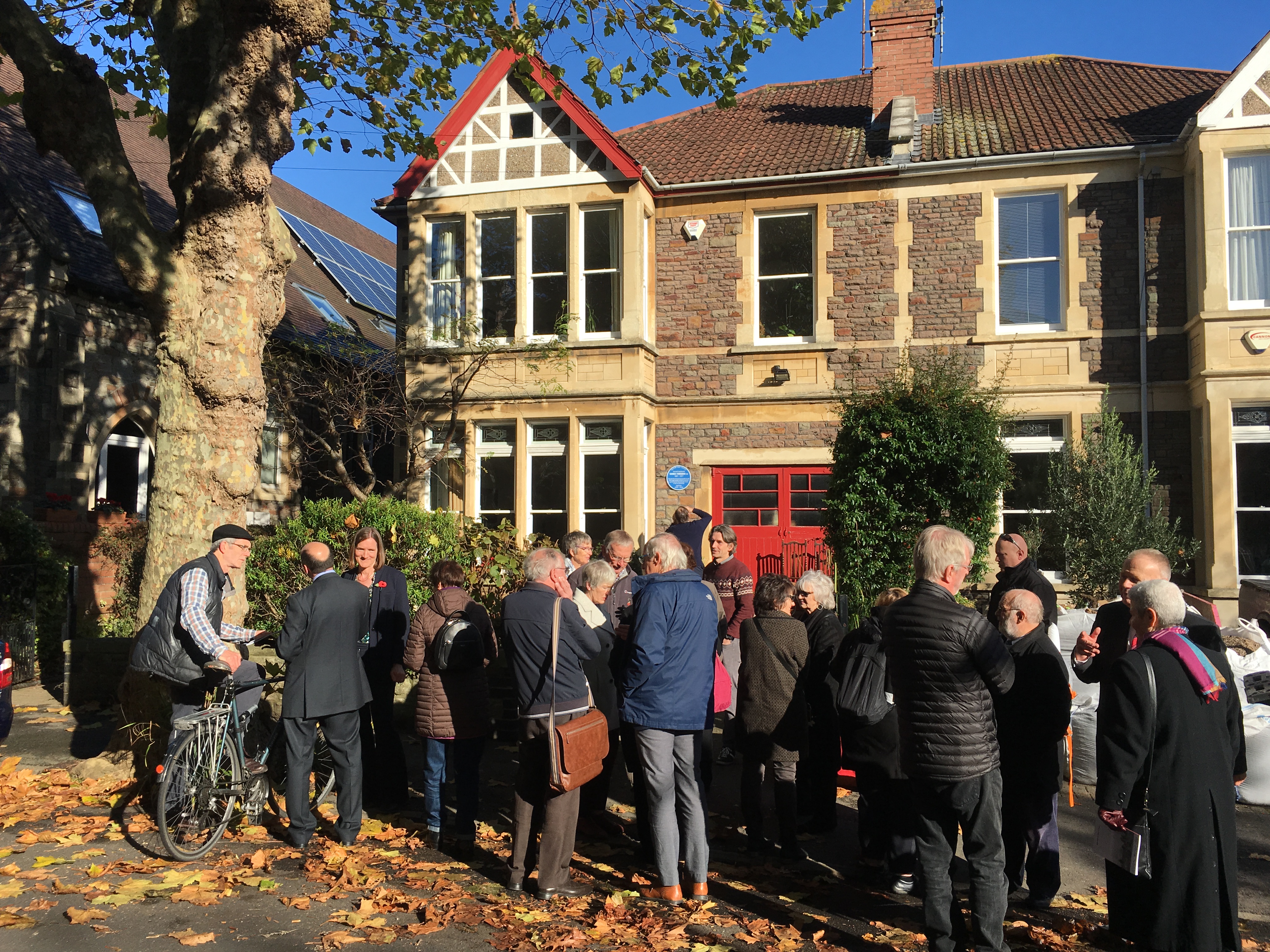
After the ceremony many of those attended were able to mingle and discuss Hardy’s life
Bristol 24/7 have also covered the story: https://www.bristol247.com/news-and-features/news/pictures-blue-plaque-revealed-wwi-soldier-redland/ as have BBC News: http://www.bbc.co.uk/news/uk-england-bristol-41918314. Our BBC Points West interview is available for a week from 16 minutes in here: https://www.bbc.co.uk/iplayer/episode/b09bzw5f/points-west-evening-news-08112017
The life of Hardy Falconer Parsons VC, 14th Battalion, Gloucestershire Regiment
Hardy Falconer Parsons was born on 30 June 1897 at Rishton, near Blackburn, Lancashire, the first of three boys. His father, the Rev James Ash Parsons, was a Wesleyan Minister whilst his mother Henrietta (known as Rita) was the daughter of a railway inspector from York. Hardy’s rather unusual middle name came from Rita – Falconer was her maiden name.
The Rev James Ash Parsons had spent eleven years in total in the slums of East London as superintendent of the Methodist Leysian Mission. Ill health forced him and Rita to St Anne’s on Sea, south of Blackpool and it was whilst living here that Hardy was born. There followed three years at Arnside immediately south of the Lake District. Clearly, the ethos of duty and service to others, so well practiced by his parents, was a huge part of Hardy’s upbringing.
Hardy’s first school was King Edward VII School at Lytham St Annes. From the paper work we have found it appears the family moved to Bristol in 1912 when the Rev James Ash Parsons became pastor at the Old King Street Wesleyan Chapel (sadly, now demolished). The family moved to 54 Salisbury Road in Redland and Hardy attended Kingswood School in Bath until April 1915.
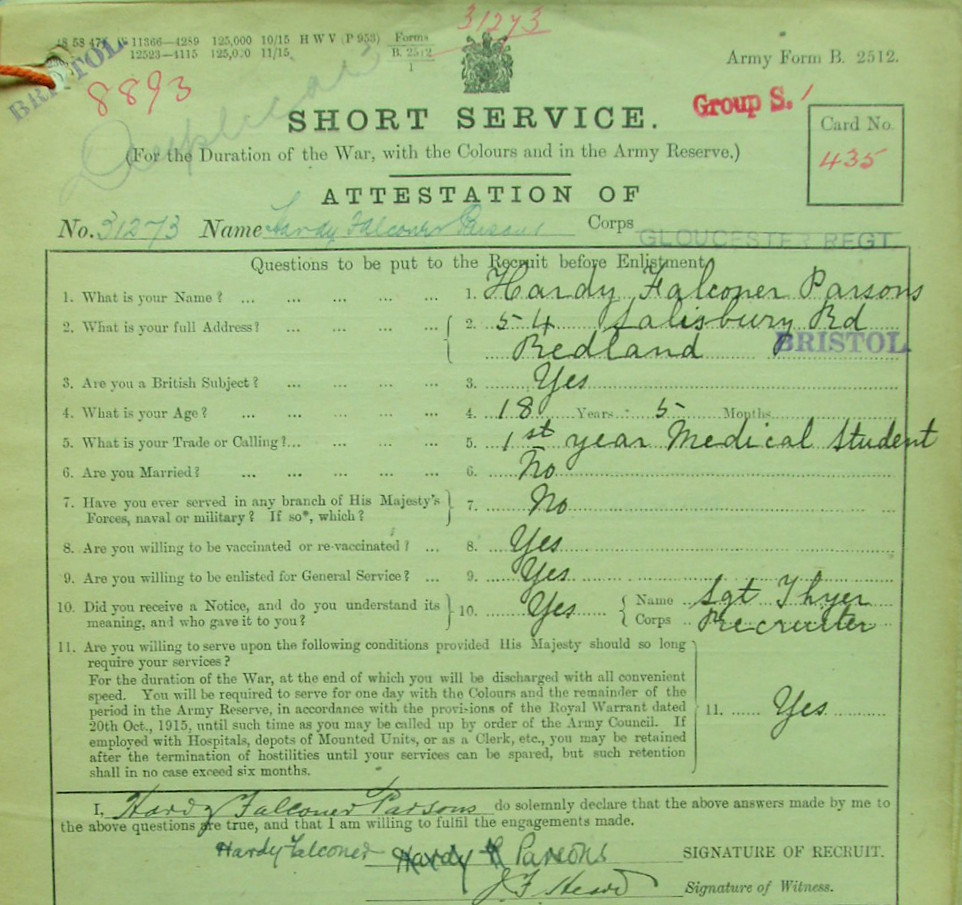
Extract from attestation papers of Hardy Falconer Parsons (National Archives: WO339/73298)
After school Hardy Parsons became a Medical Student at Bristol University with the aim of becoming a medical missionary. At the end of November 1915, during his first year at the University he signalled his wish to volunteer for service by attesting when aged just 18 years & 5 months but was immediately placed on the Army Reserve.
He had previously declined a safe post in a Government munitions laboratory, feeling that he ought not to withhold himself from the fullest sacrifice. He hated war, but recognised that the making of munitions was just as much war work as was the actual taking of life.
He joined the University’s Officer Training Corps in May 1916, a month shy of his 19th birthday, and then passed his first Bachelor of Medicine degree. His attestation papers make interesting reading – recording that he was a tall man, especially for that time, standing at 6ft ¾ inch tall. In early October 1916 he was posted to 6th Officer Cadet Battalion at Balliol College, Oxford and, on 25 January 1917, was appointed to the Gloucestershire Regiment as a Second Lieutenant.
He eventually joined the 14th Battalion in March, a unit which had previously been a ‘Bantam’ battalion – with men of 5ft 3 inches and less serving in its ranks. By the time the nearly 6ft 1 inch Hardy joined the battalion this unique distinction had been very much diluted. In February 1917 the battalion war diary records 475 ‘normal size men’ joining the battalion.
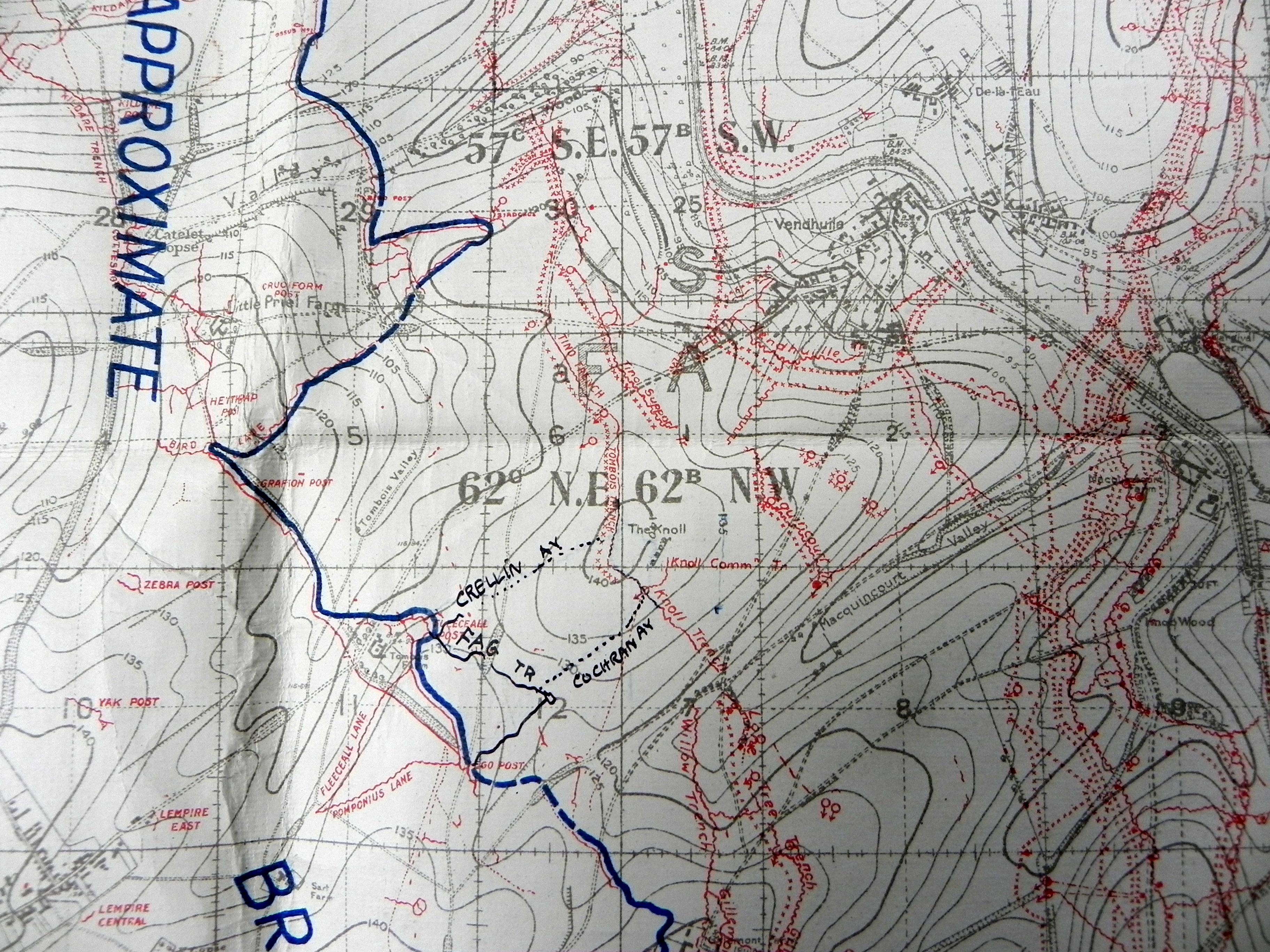
Trench map extract of The Knoll – captured by 105 Infantry Brigade on 19 August 1917
On 21 August 1917 near the village of Vendhuile in the eastern part of the Somme, Hardy’s battalion were holding recently captured trenches at a position known as The Knoll in the Hindenburg Line outpost zone. Their relief of the units who had captured the Knoll some two days before was completed by 1.30am that night.
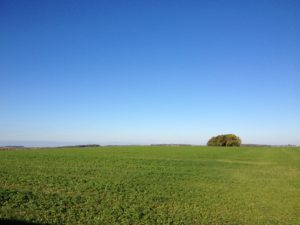
Modern view of The Knoll, photographed October 2017. Vendhuile, the Hindenburg Line and St Quentin Canal are out of view in the valley.
It was a critical position which afforded observation over the Hindenburg Line and St Quentin canal a mile away – observation the British wanted and the Germans wanted to prevent. In fact, men from Bristol’s 1/4th and 1/6th Territorial battalions had fought for the same view in this same position four months previously.
The loss of such critical terrain forced the Germans into a devastating counter-attack. As recorded in the Brigade war diary, at 3.51am the Germans struck. Militarily, it was a brilliantly executed counter-attack by the Germans – The Knoll being attacked at four points simultaneously. German infantry were accompanied by special detachments using portable flamethrowers. These forced Hardy Parsons’ men back. However, he alone stuck to his bombing post and held his position, throwing bombs (hand grenades) at approaching Germans until a British counter-attack could be launched. The counter-attack was successful – the Germans were repulsed from the trenches around The Knoll and within 40 minutes this bloody action was over. Much of this success is due to Hardy’s refusal to yield ground.
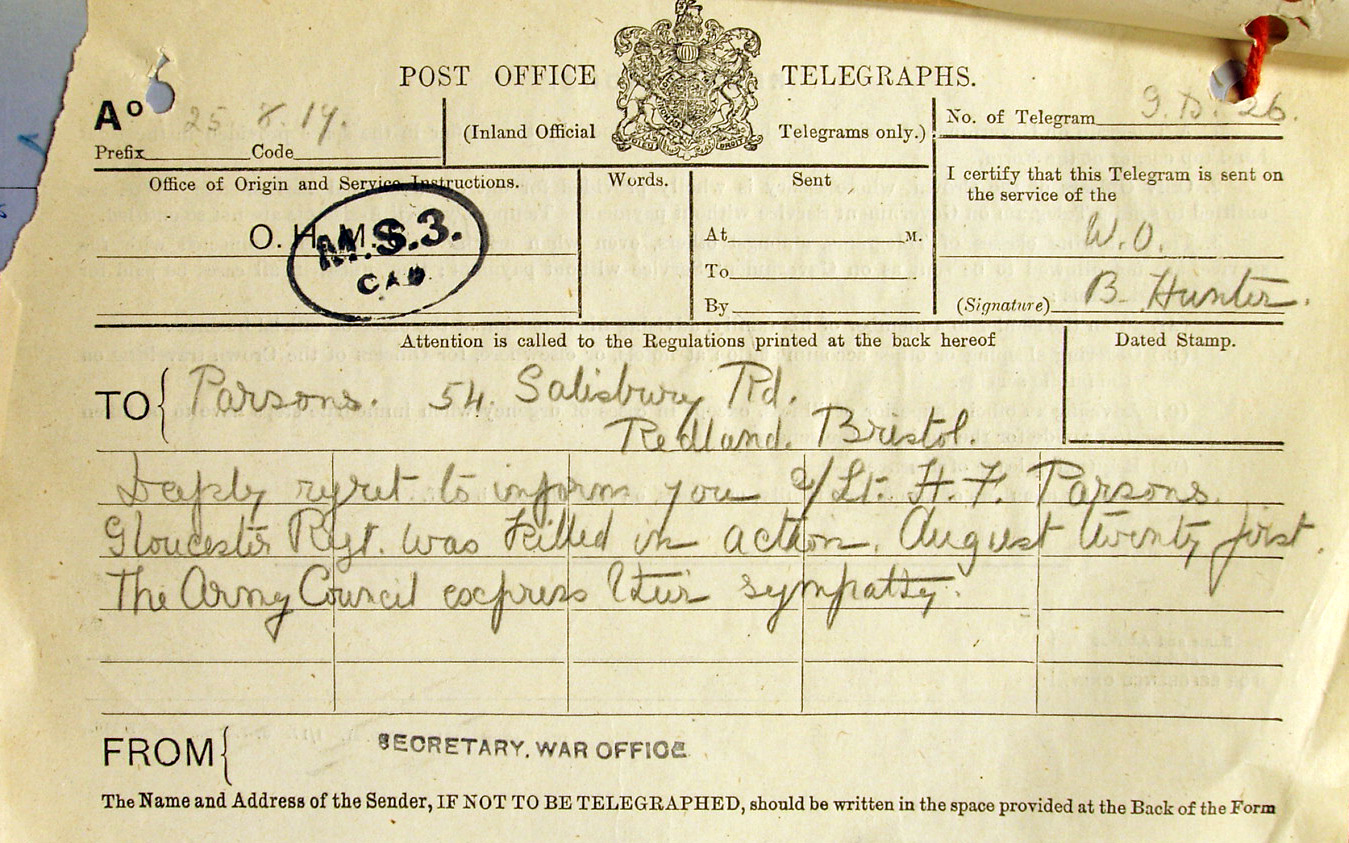
Telegram sent to the Rev James Ash Parsons informing him of Hardy’s death
During his heroic sole defence of The Knoll Hardy had been severely burnt by liquid fire. Writing these words over a hundred years later I cannot begin to imagine the sense of duty that compelled him to stay at his post, or the pain he would have endured during and after sustaining such horrific burns. Unsurprisingly, the nature of his wounds proved too severe and he succumbed later that day, dying at the age of just 20 years and two months. Hardy Falconer Parsons is buried in the immaculate CWGC cemetery at Villers-Faucon.
N.B. I was contacted in August 2019 by Dr Markus Schroeder whose great great uncle, Ernst Komander, served with the 2./Jäger 6, Jäger-Regiment 6, 195 Infanterie-Division. He tells me that regimental records show it was Jäger-Regiment 6 that led the attack on the 14th Gloucesters with the specialist flamethrowers employed by Sturmbataillon 3. Ernst Komander was wounded on the day of the attack and died of those wounds two days later. He is buried in Block 2, Grave 56 in Caudry German Military Cemetery.
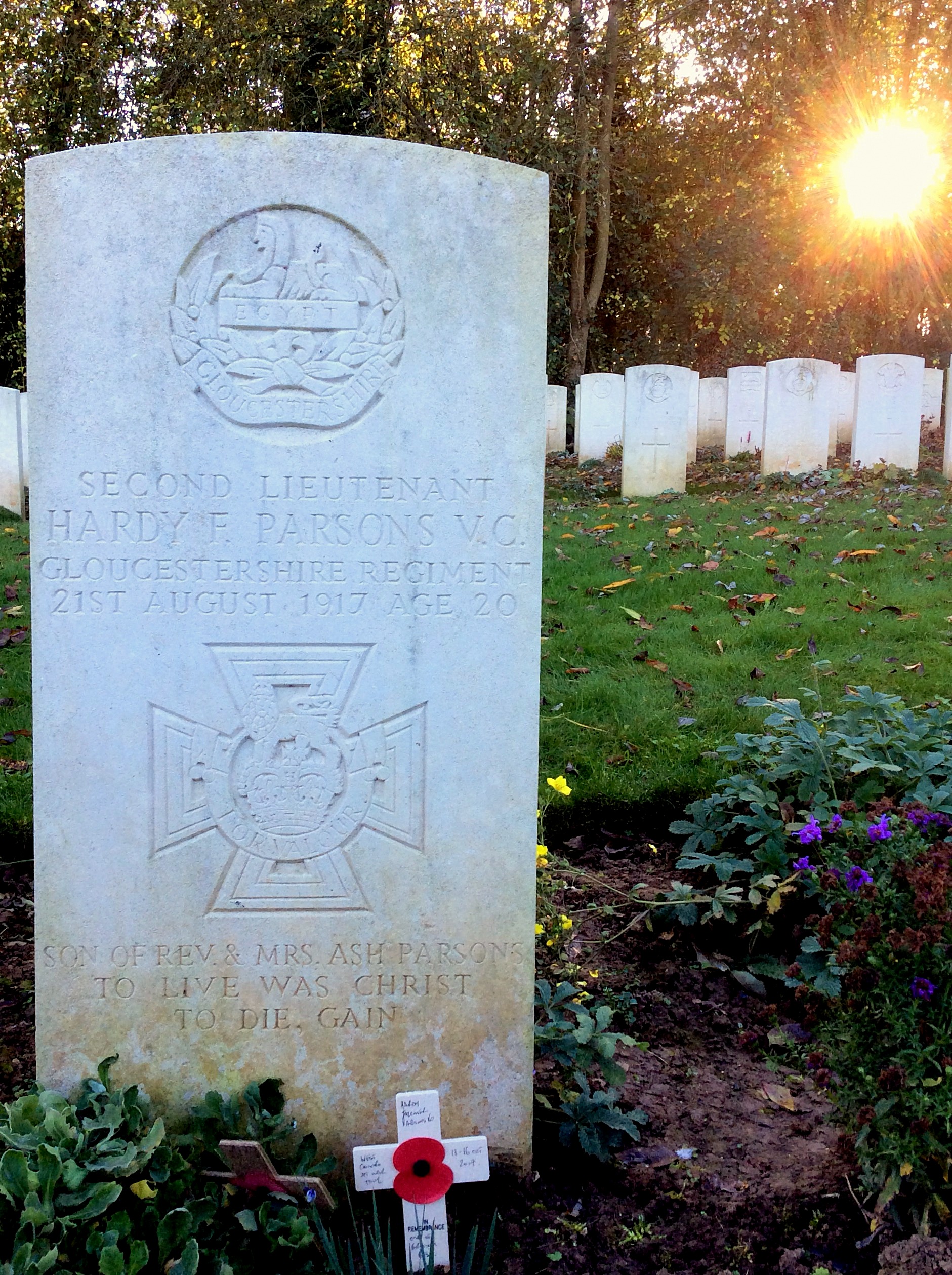
Grave of Hardy Falconer Parsons VC at Villers Faucon Communal Cemetery
Hardy’s effects, consisting of just a wrist ID disc and two wrist watches were sent by registered post to his father within the month.

105 Infantry Brigade war diary describing the events of 21 August 1917
The Brigade diary describes Hardy’s gallantry, commenting that he ‘was afterwards recommended for the VC for his action’. During the war many acts of bravery were put forward for the VC but subsequently rejected. However, in Hardy’s case, approval was given. He was posthumously awarded the Victoria Cross – personally presented to his father by King George V at a ceremony on Durdham Down (Bristol) on 8 November 1917. Hardy’s father also attended the Colston Hall event on 15 February 1919 when he was presented, on his dead son’s behalf, with an illuminated address and gold watch by Lord Mayor Twiggs. The address included Hardy’s full Victoria Cross citation:
“For most conspicuous bravery during a night attack by a strong party of the enemy on a bombing post held by his command. The bombers holding the block were forced back, but Second Lieutenant Parsons remained at his post, and, single-handed, and although severely scorched and burnt by liquid fire, he continued to hold up the enemy with bombs until severely wounded. This very gallant act of self-sacrifice and devotion to duty undoubtedly delayed the enemy long enough to allow the organisation of a bombing party, which succeeded in driving back the enemy before they could enter any portion of the trenches. This gallant officer succumbed to his wounds.”
Hardy Parsons was only the second member of the Gloucestershire Regiment to receive a VC during the First World War.

Hardy Falconer Parsons VC Chapel Memorial, Kingswood School, Bath
On 23 July 1923, a tablet in his memory was unveiled in the chapel of Kingswood School in Bath and his Victoria Cross and campaign medals are held by the Soldiers of Gloucestershire Museum, having been presented to the Gloucestershire Regiment at a ceremony in 1970 in front of what is now City Hall, attended by the Lord Mayor, Cllr Bert Wilcox.
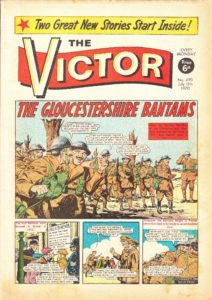
Victor comic, 11 July 1970 – the story of Hardy Falconer Parsons VC
The collection also includes a portrait photograph of Hardy in uniform; the bronze memorial plaque sent, popularly known as the “Dead Man’s Penny” to his parents after the war and his Gloucestershire Regiment collar badge. Engraved on the back of the badge are the words “Irene Randall 10 Newfoundland St., Bristol 1917”. Who she was, and why he had that, we will probably never know….
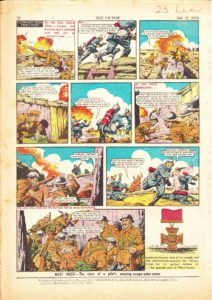
Victor comic, 11 July 1970 – the story of Hardy Falconer Parsons VC
On 11 July 1970, the Victor Comic ran a cartoon story with 10 sketches on its front and back pages, recounting the story of the 14th Gloucesters action at The Knoll and to the deeds of Hardy Falconer Parsons – bringing his heroic actions to the attention of a younger audience.
Ewart Moulton Parsons
And as for the Parsons family, despite Hardy’s death, the war had not finished with them. Hardy had two younger brothers; Ewart Moulton and Lyall Ash. Lyall was born too late to serve but Ewart, born the year after Hardy, was working as an apprentice engineer at Bristol company, Brecknell Munro and Rogers in summer 1916.
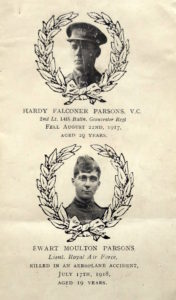
Page from memorial booklet for Hardy and Ewart Parsons
He joined the Royal Flying Corps in 1917 and by 17 July 1918, was a 19 year old Lieutenant and pilot in No.50 Training Depot Station at Eastbourne, flying his Sopwith F1 Camel fighter high above the Seaplane Station. What happened next is still unclear but his plane went into a spin and plummeted to the ground from 3000ft. Unsurprisingly, Ewart was killed instantly.
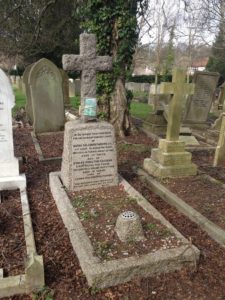
Grave of Ewart Parsons in Canford Cemetery, Bristol
His body was brought back to Bristol and his funeral held at the Old King Street Wesleyan Chapel where his father was the pastor. The coffin was borne by six RAF officers and taken on a gun carriage to Canford Cemetery, where the internment took place followed by the sounding of the Last Post.
So, in the space of eleven months James Ash and Rita Parsons had lost two of their three boys. On the base of the stone cross marking Ewart’s grave at Canford Cemetery the family also commemorated his brother, Hardy. Like so many families across the world, the Parsons’ suffered grievously in the war.
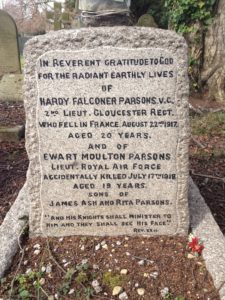
Detail on Ewart Parsons’ grave in Canford Cemetery
But, as this research is primarily based on Hardy I would like to end with a description of him, provided by his father which, when considered alongside his Victoria Cross action, shows him to have been a truly remarkable young man, a perfect example of the loss of the best of that generation:
“Hardy lived all of his life from early childhood on the same high plane of self-forgetfulness and sacrifice in his thought for and service of others”
Hardy Falconer Parsons VC (30 June 1897 – 21 August 1917)
Sources of information consulted for this article include:
Service record of Hardy Falconer Parsons VC (National Archives: WO339/73298)
105 Infantry Brigade War Diary (National Archives: WO95/2486)
14 Battalion Gloucestershire Regiment War Diary (National Archives: WO95/2486)
RAF service record of Ewart Moulton Parsons
Census returns (1901 & 1911)
Material from the Soldiers of Gloucestershire Museum http://www.soldiersofglos.com/
Victor Comic, 11 July 1970
London Gazette – various dates
The Kingswood Magazine, Vol. XX, No.10, December 1917
North Devon Journal, 27 August 1931
North Devon Journal, 10 November 1949
Gliddon, Gerald, VCs of the First World War: Cambrai 1917, Stroud, 2004

Second Lieutenant Hardy Falconer Parsons VC, 14th Gloucestershire Regiment. Image courtesy Soldiers of Gloucestershire Museum, Ref GLRRM:04750.6
On 8 November 2017 a Bristol Civic Society Blue Plaque for Hardy Falconer Parsons VC, 14th Gloucestershire Regiment (my local Victoria Cross recipient) will be unveiled at 54 Salisbury Road, Redland, Bristol. The date is 100 years to the day after King George V personally presented Hardy’s VC to his father, Rev James Ash Parsons at a ceremony on Durdham Downs.
Between 2014 and 2019 the Government is funding the production and placing of a commemorative stone for each and every Victoria Cross recipient of the First World War. Although Hardy Falconer Parsons lived at 54 Salisbury Road, he was not born in Bristol. So in August the government-funded commemorative stone relating to Hardy Parsons, was laid in Rishton, Lancashire.
Local historian and author Clive Burlton and I were determined to see Hardy’s strong association with Bristol and the West Country recognised. If we couldn’t have the government-funded stone in Bristol, the next best thing was to have a Bristol Blue plaque unveiled in his honour.
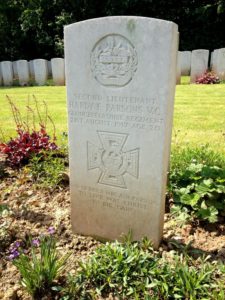
The grave of Hardy Falconer Parsons VC at Villers-Faucon Communal Cemetery
So, during the past year we have organised for the creation of the plaque. Wednesday’s ceremony, starting at 11am, will have representatives from the Bristol Civic Society; the former Gloucestershire Regiment; the Soldiers of Gloucestershire Museum; the Bristol University Officer Training Corps; Kingswood School, Bath, Redland Green School and Dolphin Schools in Bristol; bandsmen from the Salamanca Band of the Rifles Regiment; the Western Front Association; members of the Bristol Great War network and representatives of the Kingswood Association, whose generous donation enabled the plaque to be made and installed. Also attending are the Lord Mayor of Bristol, Cllr Lesley Alexander; the Deputy Lord-Lieutenant for the County and City of Bristol, Colonel Andrew Flint and the Dean of Bristol, the Very Rev Dr David Hoyle.
The event is open to the public so please do come along and attend if you can. I will be posting the results of my research on Hardy Parsons along with photos of Wednesday’s ceremony on my website later this week. In the meantime, it is worth reading Hardy’s VC citation to have an idea of his valour:
“For most conspicuous bravery during a night attack by a strong party of the enemy on a bombing post held by his command. The bombers holding the block were forced back, but Second Lieutenant Parsons remained at his post, and, single-handed, and although severely scorched and burnt by liquid fire, he continued to hold up the enemy with bombs until severely wounded. This very gallant act of self-sacrifice and devotion to duty undoubtedly delayed the enemy long enough to allow the organisation of a bombing party, which succeeded in driving back the enemy before they could enter any portion of the trenches. This gallant officer succumbed to his wounds.”
There should be a short film on Hardy’s action on Wednesday evening’s Points West (BBC1) from 6.30pm.
Following the success of last year’s ‘Bristol on the Western Front’ trip that I organised with fellow historian, Clive Burlton, we are pleased to announce another trip for October 2017.
This year we are broadening the net with less of a Bristolian focus. Stops will cover actions by units from Wiltshire, Somerset and South Wales. As such, we thought it apt to name the tour ‘The West Country at War’.
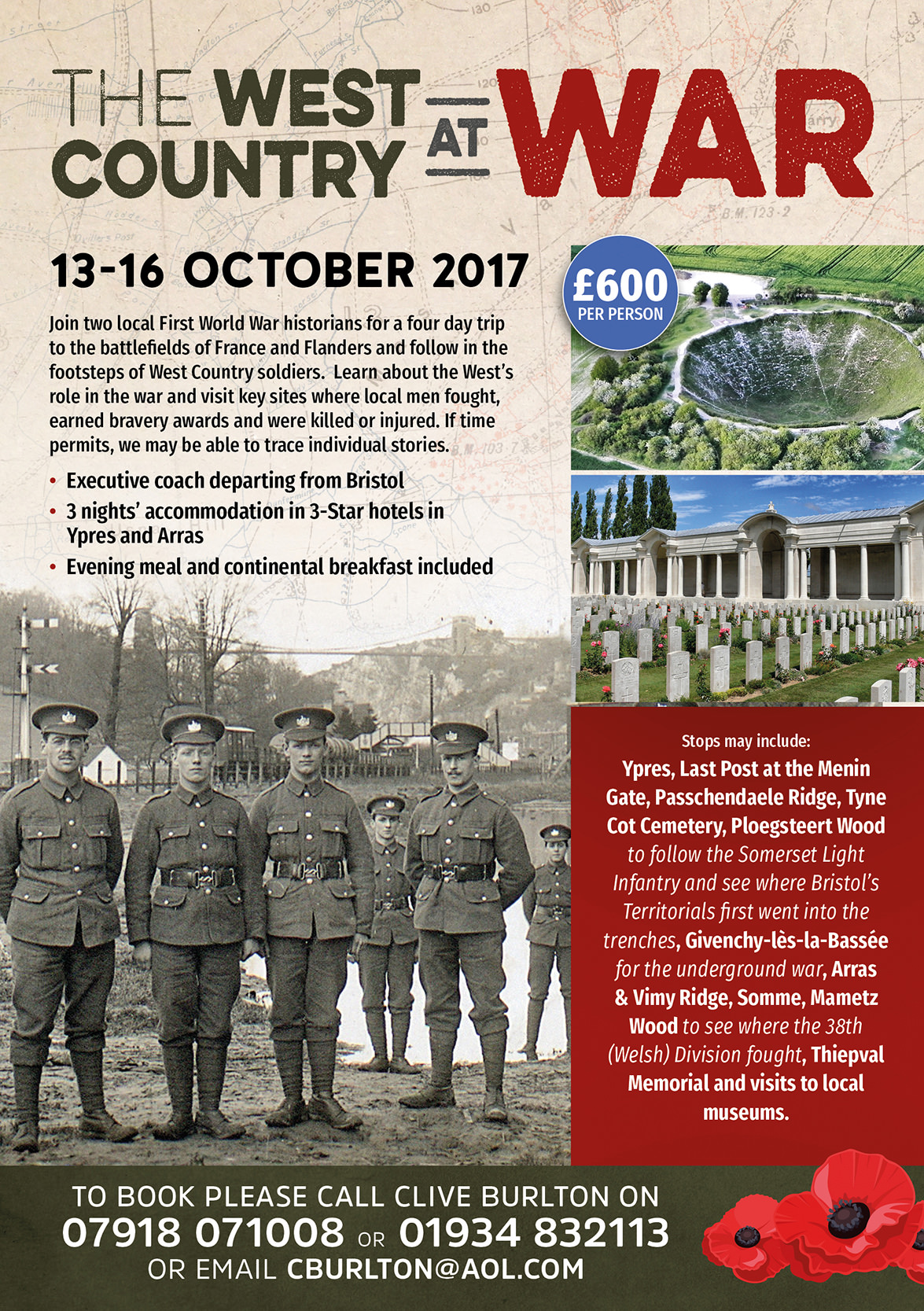
Once again we are travelling with our partners at Bakers Dolphin. The three night, four day tour will visit key sites where soldiers from the West Country fought, earned bravery awards and lost their lives.
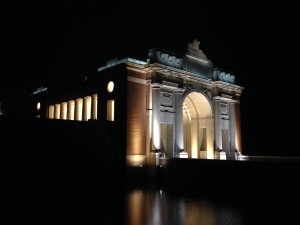
Menin Gate, Ypres
Travelling by executive coach we will depart from Bristol on 13 October and travel to Arras, stopping at sites of interest en route. The next day will be spent on the Somme battlefields, visiting some well known (Mametz Wood) as well as lesser known sites on the 1917 battlefield!
The following day sees us journey northward to the sacred Ypres salient , the wartime cauldron for so many of Britain’s soldiers. Whilst in Ypres we will attend the Last Post ceremony at the Menin Gate. Our time in Ypres will see us visiting sites around the salient including Ploegsteert (known as Plugstreet to the Tommies) to follow the 1st Somerset Light Infantry in December 1914, see where the Christmas Truce took place and visit the area in which Bristol’s Territorials first went into the trenches.
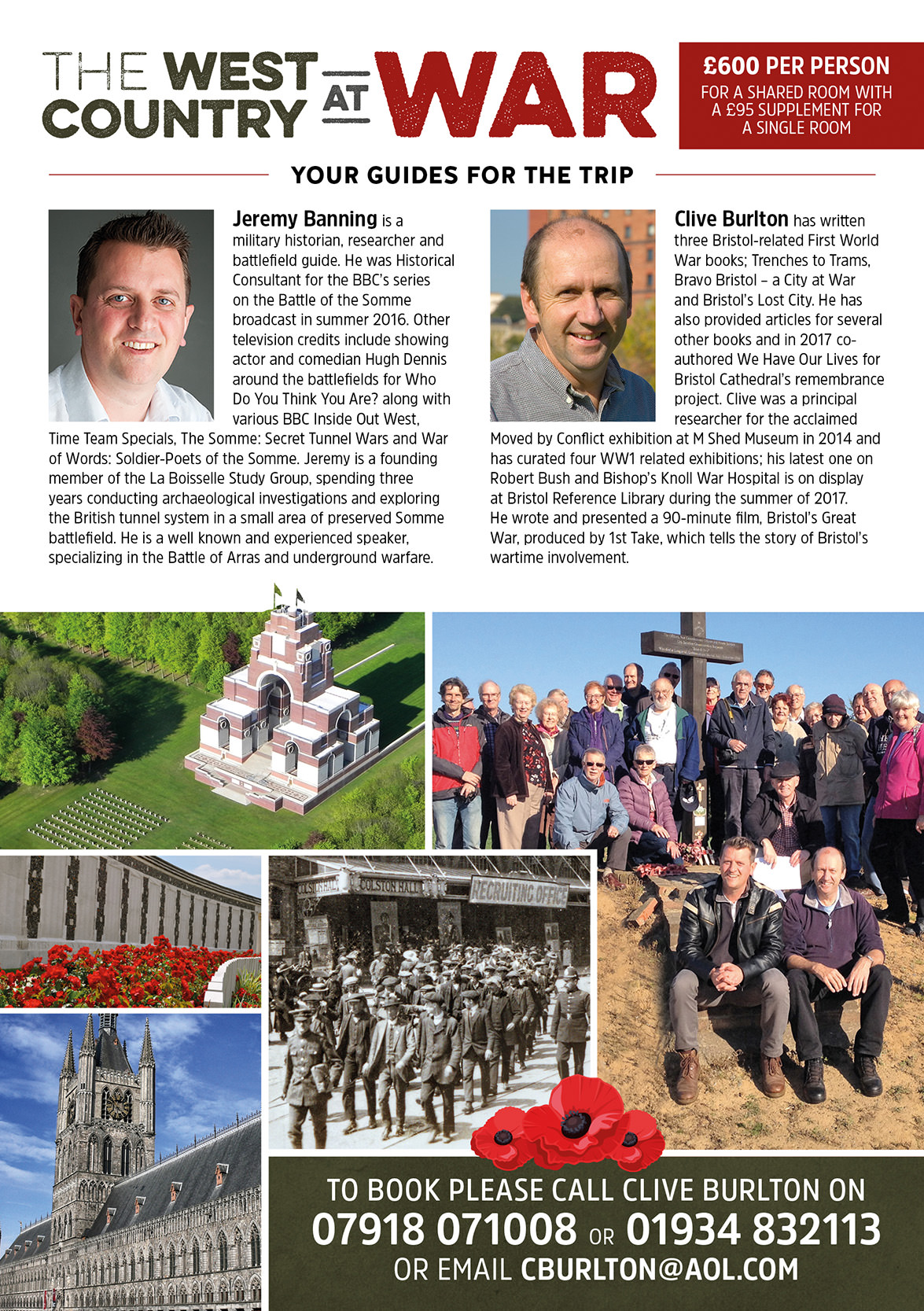
Accommodation is based at the following 3-star hotels – Holiday Inn Express (Arras) and the Novotel (Ypres). Evening meal and continental breakfast are included. If there is demand then Clive and I are happy to give evening talks. Last year we were heartened by the almost 100% attendance rate at our talks by those who had already had a long day on the battlefields.
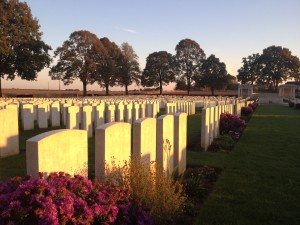
Delville Wood Cemetery, Somme
Full details of cost and contact details to reserve a space can be found on the attached flyer.
We look forward to you joining us for another wonderful few days!
